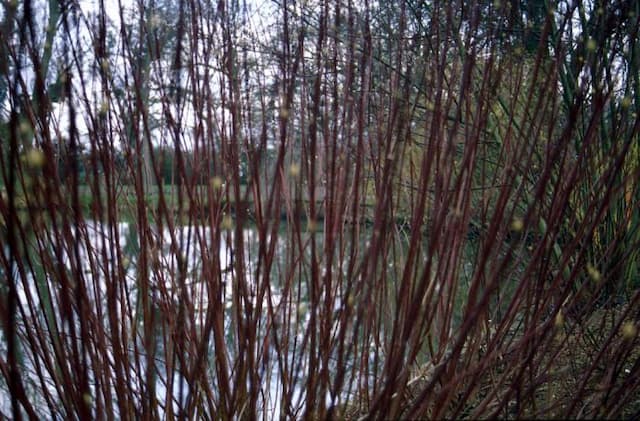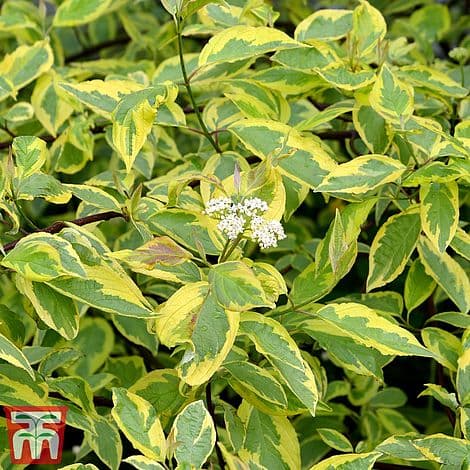Bloodtwig Dogwood Cornus sanguinea 'Anny'











ABOUT
Cornus sanguinea 'Anny', commonly known as Bloodtwig Dogwood 'Anny', is a deciduous shrub that is widely appreciated for its striking visual appeal across different seasons. It showcases a multi-stemmed habit with branches that gracefully arch outwards, creating a rounded and somewhat open structure. The plant is well-known for its stems, which display a rich color that can range from deep red to dark purple, becoming especially vibrant amidst the winter landscape when the foliage has fallen. The leaves of the Bloodtwig Dogwood 'Anny' are ovate to lanceolate in shape with an elegant pointed tip. During the growing season, the leaves are lush green and may exhibit a subtle texture with visible veins running parallel to the margins, providing a beautiful contrast against the colorful stems. In autumn, the foliage undergoes a dramatic change, presenting a magnificent display of fiery shades that include oranges, reds, and purples before they eventually drop. Springtime brings small, flat-topped clusters of flowers that are creamy white in color. These blooms are not overly showy but add a soft textural effect to the shrub. Following the flowering period, the plant produces small, spherical berries that are appealing to birds and other wildlife. The berries may start out as a light color and ripen to a darker shade, often black or blue, adding another layer of interest to the shrub's seasonal progression. The combination of the Bloodtwig Dogwood 'Anny's multi-season interest, with its colorful stems, dynamically changing foliage, subtle spring flowers, and berry display, make it a valued addition to many gardens for its ornamental qualities. Its appearance contributes to its popularity among gardeners who seek to add color and texture to their landscape throughout the year.
About this plant
 Names
NamesFamily
Cornaceae
Synonyms
Bloodtwig Dogwood, Winter Flame, Midwinter Fire
Common names
Swida sanguinea, Thelycrania sanguinea.
 Toxicity
ToxicityTo humans
Bloodtwig dogwood, the common name for Cornus sanguinea 'Anny', has not been widely reported to be toxic to humans. However, as with many plants, it is recommended to avoid ingestion as it may cause mild stomach upset. There are no well-documented cases of poisoning from Bloodtwig dogwood, so the consequences of ingestion are not clearly defined. If any part of the plant is ingested and symptoms occur, it is advisable to seek medical attention.
To pets
Bloodtwig dogwood, also known to pets as simply the dogwood, is not typically considered toxic to pets. While the plant is generally seen as safe, it is still recommended that pets do not consume the plant, as parts of it could potentially cause mild gastrointestinal upset in some animals. If a pet ingests part of a Bloodtwig dogwood and shows signs of distress or illness, it is best to contact a veterinarian.
 Characteristics
CharacteristicsLife cycle
Perennials
Foliage type
Deciduous
Color of leaves
Green
Flower color
White
Height
4-6 feet (1.2-1.8 meters)
Spread
4-6 feet (1.2-1.8 meters)
Plant type
Shrub
Hardiness zones
4
Native area
Europe
Benefits
 General Benefits
General Benefits- Attractive Foliage – 'Anny' boasts vibrant green leaves that transition to striking shades of purple and red in the fall, providing seasonal interest.
- Wildlife Habitat – Offers shelter and nesting sites for birds, while its flowers attract pollinators such as bees and butterflies.
- Ornamental Berries – Produces a showy array of blue or white berries that can add visual appeal to the garden and attract fruit-eating birds.
- Low Maintenance – Once established, it requires minimal care, making it suitable for gardeners of all skill levels.
- Drought Tolerance – Exhibits a degree of drought resistance, which can be beneficial in regions with water restrictions or less frequent rainfall.
- Soil Adaptability – Able to thrive in a variety of soil conditions, from well-drained to clay soils, as long as the soil is not waterlogged.
- Seasonal Screen – Can be used effectively as a hedge or privacy screen, offering seasonal foliage and a dense growth habit.
- Structure in Garden Design – Its multi-stemmed habit and varying height can provide structural interest in a garden or landscape design.
 Medical Properties
Medical PropertiesThis plant is not used for medical purposes.
 Air-purifying Qualities
Air-purifying QualitiesThis plant is not specifically known for air purifying qualities.
 Other Uses
Other Uses- Photography Backdrop: The vibrant red stems of the Cornus sanguinea 'Anny', commonly known as Dogwood, can provide a stunning natural backdrop for photographers, especially in winter scenes.
- Ink Production: The bark and leaves of the Dogwood, when boiled, can produce a light to medium brown dye which can be used for making natural inks.
- Fabric Dyeing: The same natural dye obtained from the Dogwood can be used to tint textiles and provide them with earthy tones.
- Tool Handles: Although not the primary use, the hard wood of the Dogwood can be fashioned into sturdy handles for garden implements or small tools.
- Fishing Rods: In the past, the straight stems of the Dogwood were sometimes used to make traditional fishing rods.
- Bird Habitat: Planting Dogwood shrubs can provide birds with shelter and foraging ground, supporting biodiversity in your garden.
- Living Fences: Dogwood can be used to create a natural and decorative living fence that marks property borders or divides garden spaces.
- Charcoal Production: When burned in low oxygen situations, Dogwood wood can produce charcoal, which can be used for drawing or as a soil amendment.
- Educational Tool: The distinct seasonal changes in the Dogwood’s appearance can serve as a teaching aid for educational programs about plant life cycles and botany.
- Woodworking Projects: For hobbyists, the wood of the Dogwood can be used for small woodworking projects such as crafting wooden toys or decorative objects.
Interesting Facts
 Feng Shui
Feng ShuiThe Bloodtwig Dogwood is not used in Feng Shui practice.
 Zodiac Sign Compitability
Zodiac Sign CompitabilityThe Bloodtwig Dogwood is not used in astrology practice.
 Plant Symbolism
Plant Symbolism- Stability and Hope: Cornus sanguinea, commonly known as 'Bloodtwig Dogwood', is often associated with stability and hope due to its hardy nature and the way it stands out in a winter landscape, reminding people that warmer days will come.
- Resilience: The Bloodtwig Dogwood's ability to thrive in a variety of conditions symbolizes resilience and the capacity to endure challenges.
- Rebirth: As a plant that transitions through seasons with vibrant colors, it embodies the concept of rebirth and new beginnings.
- Determination: The strong and upright growth habit of the Bloodtwig Dogwood represents determination and integrity.
- Protection: In some cultures, dogwoods are thought to have protective qualities, making them a symbol of safety.
 Water
WaterThe common dogwood or Bloodtwig dogwood (Cornus sanguinea 'Anny') should be watered deeply to saturate the root zone, and then allowed to dry out slightly before the next watering. Initially, water the plant once a week with about 1-2 gallons, depending on soil type and weather conditions. Adjust the frequency to every two weeks once the plant is established, and more during dry spells or hot weather. Overwatering can lead to root rot, so ensure the plant is not sitting in waterlogged soil. During the winter months, reduce watering since the plant will be dormant and require less moisture.
 Light
LightBloodtwig dogwood prefers full sun to partial shade conditions, thriving in areas that receive at least four to six hours of direct sunlight daily. The ideal spot would be where it can enjoy morning sun and have some protection from the intense heat of the afternoon sun, particularly in hotter climates. However, it will also grow well in light, dappled shade under taller trees, as long as it is not too deep.
 Temperature
TemperatureBloodtwig dogwood is hardy and can tolerate a wide temperature range, but it grows best in temperatures between 60°F to 75°F. It can survive minimum winter temperatures down to -30°F and maximum summer temperatures up to around 95°F. It is important to avoid exposing the plant to extreme heat for prolonged periods or sudden frost after new growth has begun.
 Pruning
PruningBloodtwig dogwood benefits from pruning to maintain shape, encourage colorful new stems, and remove any dead or diseased wood. The best time to prune is in late winter or early spring before the new growth starts. Typically, cutting back about one-third of the oldest stems to ground level each year will stimulate the growth of new shoots, which carry the brightest color. Light pruning to shape the plant can be done at any time during the growing season.
 Cleaning
CleaningAs needed
 Soil
SoilFor Bloodtwig Dogwood (Cornus sanguinea 'Anny'), the best soil mix is well-draining, fertile soil with a significant amount of organic matter. A mix of two parts loam, one part sand, and one part compost or well-rotted manure will create a suitable environment. The ideal soil pH for Bloodtwig Dogwood should be between 5.5 and 7.5.
 Repotting
RepottingBloodtwig Dogwood (Cornus sanguinea 'Anny') generally does not require frequent repotting as it is most commonly grown outdoors. The plant may be transplanted or divided for propagation or if it outgrows its space. It is typically done in late fall or early spring before the growing season begins.
 Humidity & Misting
Humidity & MistingBloodtwig Dogwood (Cornus sanguinea 'Anny') tolerates a wide range of humidity levels but prefers average to high humidity. Outdoor specimens are usually well adapted to local conditions, whereas indoor plants benefit from occasional misting.
 Suitable locations
Suitable locationsIndoor
Place Bloodtwig Dogwood near a window and avoid dry air.
Outdoor
Plant in moist, well-drained soil with sun or partial shade.
Hardiness zone
4-7 USDA
 Life cycle
Life cycleThe common name for Cornus sanguinea 'Anny' is the Bloodtwig Dogwood or Common Dogwood. It begins its lifecycle as a seed, which under appropriate conditions of warmth and moisture germinates in the soil. Once germination occurs, it enters its seedling stage, where initial roots and shoots begin to develop. As it matures into a sapling, the Bloodtwig Dogwood prioritizes stem and leaf growth, eventually reaching its full mature stage with a well-developed root system and branching structure, which is capable of flowering and producing its characteristic small white flowers. Upon pollination, these flowers develop into small, inedible berries that contain seeds, allowing for the cycle of reproduction to continue. Throughout its life, Bloodtwig Dogwood experiences annual cycles of growth and dormancy, with vibrant red stems that are particularly notable in the winter.
 Propogation
PropogationPropogation time
Spring-Early Summer
Propogation: Cornus sanguinea 'Anny,' commonly known as Bloodtwig Dogwood, is most effectively propagated through hardwood cuttings. This method is typically performed in late fall after the leaves have dropped, or in early winter. Take cuttings from healthy, mature stems that are about 6 to 9 inches long and have a diameter of about 1/4 inch (6.35 mm [metric]), ensuring each cutting has several nodes. Dip the cutting's base in rooting hormone to encourage root development, and then plant the cuttings in a well-drained potting mix. The container should be placed in a cold frame or an area protected from extreme cold and wind. Keep the soil consistently moist but not waterlogged. Roots and shoots will usually begin to develop by the following spring, at which point they may be transplanted to a more permanent location.









